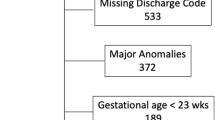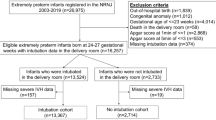Abstract
Objective
To determine 1-year survival in a cohort of newborns with an Apgar score of 0 at 5 and 10 min of age.
Study design
A retrospective cohort study of the Washington State Comprehensive Hospital Abstract Reporting System from 2005 to 2014.
Results
Of 879,340 births, 199 (0.02%) had an Apgar score of 0 at 5 min, and 109 (0.01%) also had a score of 0 at 10 min. One-year survival was 46% for newborns with Apgar score of 0 at 5 and 10 min. One-year survival by gestational age was 4% for newborns <30 weeks, 38% for 30–35 weeks, and 67% for ≥36 weeks.
Conclusion
Survival at 1 year of age for newborns with an Apgar score of 0 at 5 and 10 min has improved, as compared with historic cohorts. Cautious optimism is warranted since morbidity-free survival could not be assessed.
This is a preview of subscription content, access via your institution
Access options
Subscribe to this journal
Receive 12 print issues and online access
$259.00 per year
only $21.58 per issue
Buy this article
- Purchase on Springer Link
- Instant access to full article PDF
Prices may be subject to local taxes which are calculated during checkout



Similar content being viewed by others
References
Apgar V. A proposal for a new method of evaluation of the newborn infant. Curr Res Anesth Analg. 1953;32:260–7.
Finster M, Wood M. The Apgar score has survived the test of time. Anesthesiology. 2005;102:855–7.
Apgar V. The newborn (Apgar) scoring system. Reflections and advice. Pedia Clin North Am. 1966;13:645–50.
American Academy of Pediatrics Committee on Fetus and Newborn, American College of Obstetricians and Gynecologists Committee on Obstetric Practice. The Apgar score. Pediatrics. 2015;136:819–22.
Patel H, Beeby PJ. Resuscitation beyond 10 min of term babies born without signs of life. J Paediatr Child Health. 2004;40:136–8.
Natarajan G, Shankaran S, Laptook AR, Pappas A, Bann CM, McDonald SA, et al. Apgar scores at 10 min and outcomes at 6–7 years following hypoxic-ischaemic encephalopathy. Arch Dis Child Fetal Neonatal Ed. 2013;98:F473–9.
Sarkar S, Bhagat I, Dechert RE, Barks JD. Predicting death despite therapeutic hypothermia in infants with hypoxic-ischaemic encephalopathy. Arch Dis Child Fetal Neonatal Ed. 2010;95:F423–8.
Laptook AR, Shankaran S, Ambalavanan N, Carlo WA, McDonald SA, Higgins RD, et al. Outcome of term infants using apgar scores at 10 min following hypoxic-ischemic encephalopathy. Pediatrics. 2009;124:1619–26.
Harrington DJ, Redman CW, Moulden M, Greenwood CE. The long-term outcome in surviving infants with Apgar zero at 10 min: a systematic review of the literature and hospital-based cohort. Am J Obstet Gynecol. 2007;196:463 e1–5.
Wyckoff MH, Aziz K, Escobedo MB, Kapadia VS, Kattwinkel J, Perlman JM, et al. Part 13: neonatal resuscitation: 2015 American Heart Association guidelines update for cardiopulmonary resuscitation and emergency cardiovascular care. Circulation. 2015;132:S543–60.
Perlman JM, Wyllie J, Kattwinkel J, Wyckoff MH, Aziz K, Guinsburg R, et al. Part 7: NeonatalResuscitation: 2015 International Consensus on cardiopulmonary resuscitation and emergency cardiovascular care science with treatment recommendations. Circulation. 2015;132:S204–41.
Kasdorf E, Laptook A, Azzopardi D, Jacobs S, Perlman JM. Improving infant outcome with a 10 min Apgar of 0. Arch Dis Child Fetal Neonatal Ed. 2015;100:F102–5.
Halling C, Raymond T, Brown LS, Ades A, Foglia E, Allen E, et al. Neonatal cardiopulmonary resuscitation in the delivery room: review of the get with the guidelines-resuscitation registry. Pediatrics. 2018;141:542.
Bloch JR, Dawley K, Suplee PD. Application of the Kessner and Kotelchuck prenatal care adequacy indices in a preterm birth population. Public Health Nurs. 2009;26:449–59.
Mya KS, Laopaiboon M, Vogel JP, Cecatti JG, Souza JP, Gulmezoglu AM, et al. Management of pregnancy at and beyond 41 completed weeks of gestation in low-risk women: a secondary analysis of two WHO multi-country surveys on maternal and newborn health. Reprod Health. 2017;14:141.
George B, Seals S, Aban I. Survival analysis and regression models. J Nucl Cardiol. 2014;21:686–94.
Kamlin CO, O’Donnell CP, Everest NJ, Davis PG, Morley CJ. Accuracy of clinical assessment of infant heart rate in the delivery room. Resuscitation. 2006;71:319–21.
van Vonderen JJ, Hooper SB, Kroese JK, Roest AA, Narayen IC, van Zwet EW, et al. Pulse oximetry measures a lower heart rate at birth compared with electrocardiography. J Pediatr. 2015;166:49–53.
Fischer N, Soraisham A, Shah PS, Synnes A, Rabi Y, Singhal N, et al. Extensive cardiopulmonary resuscitation of preterm neonates at birth and mortality and developmental outcomes. Resuscitation. 2019;135:57–65.
Wyckoff MH, Salhab WA, Heyne RJ, Kendrick DE, Stoll BJ, Laptook AR, et al. Outcome of extremely low birth weight infants who received delivery room cardiopulmonary resuscitation. J Pedia. 2012;160:239–44 e2.
Shah P, Anvekar A, McMichael J, Rao S. Outcomes of infants with Apgar score of zero at 10 min: the West Australian experience. Arch Dis Child Fetal Neonatal Ed. 2015;100:F492–4.
Shah PS, Zao J, Ali S. Knowledge synthesis group of determinants of preterm LBWb. Maternal marital status and birth outcomes: a systematic review and meta-analyses. Matern Child Health J. 2011;15:1097–109.
Acknowledgements
The authors would like to thank the Washington Department of Health for granting us access to the CHARS data.
Author information
Authors and Affiliations
Corresponding author
Ethics declarations
Conflict of interest
The authors declare that they have no conflict of interest.
Additional information
Publisher’s note: Springer Nature remains neutral with regard to jurisdictional claims in published maps and institutional affiliations.
Supplementary information
Rights and permissions
About this article
Cite this article
Billimoria, Z., Chabra, S., Patel, A. et al. Apgar score of 0 at 10 min and survival to 1 year of age: a retrospective cohort study in Washington state. J Perinatol 39, 1620–1626 (2019). https://doi.org/10.1038/s41372-019-0454-2
Received:
Revised:
Accepted:
Published:
Issue Date:
DOI: https://doi.org/10.1038/s41372-019-0454-2



